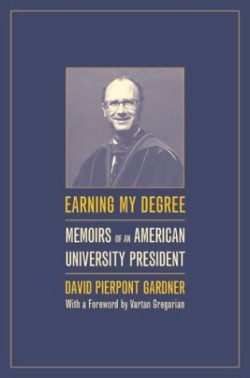Earning My Degree
Memoirs of an American University President
A tranquil and protected life in the ivory tower is rarely enjoyed by faculty and never experienced by university presidents. Wachman, in his engaging memoir, mentions that being president of Temple University, Philadelphia’s large urban state school, is “more like being a small city mayor.” Gardner, in his more detailed and scholarly autobiography, demonstrates that serving as president of the massive nine-campus University of California was, at times, like being the leader of an emerging banana republic. Not infrequently have university presidents seen their careers shattered by internal and external legislative politics. These two highly regarded presidents served as CEOs of their universities for ten years each, no mean feat in the highly charged environment of higher education.
Immediately before his university presidency (1983—1992), Gardner was president of the University of Utah for ten years. During the 1960s, he was an administrator at the University of California at Santa Barbara, where he experienced the destructive protests of the free speech and antiwar movements. While president, Gardner endured mass confrontations, which he describes in fascinating detail, over affirmative action and divestment in South Africa.
Gardner took the controversial stand of opposing divestment of the university’s financial holdings in companies that did business with South Africa, while the nation’s black citizens were victims of racist apartheid laws. His unpopular position that South African policies could be modified without divestment and that he had a fiduciary responsibility to protect university assets embroiled the campus and led to death threats against his family. The board of regents opposed his position and eventually voted to divest. Gardner’s reputation was tarnished briefly, an unfortunate outcome for a president who improved diversity and increased minority scholarships during his tenure.
Gardner’s successes outnumbered his challenges, which also included the economic collapse of the early 1990s and a media-stoked confrontation over his retirement benefits. His excellent relationship with Governor George Deukmejian led to a remarkable thirty-two percent budget increase, which reestablished the university’s preeminence and cushioned the future budget crisis. Enrollment increased significantly and became more diverse and the system awarded ten percent of all doctoral degrees granted by American universities.
Wachman, like Gardner, had parents who imparted a love of learning. He was also a skilled tennis player, which opened academic doors that would have remained closed during the Depression. Wachman received tennis scholarships to Northwestern University and the University of Illinois. In 1935, he lost the National Junior Tennis Championship to future Wimbledon star Bobby Riggs.
Wachman’s passionate concern for racial equality led to his appointment as president of Lincoln University in 1960, America’s oldest historically black college. His revealing account of Lincoln at the start of the 1960s civil rights movement is the book’s most captivating section. Lincoln became a national and international center of the movement and had enrolled more than a hundred students who were forced out of Africa for anti-apartheid protests. In addition to civil rights issues, he met more typical challenges of earning reaccredidation, appeasing alumni following the elimination of the football program, and making Lincoln a co-educational institution.
By 1969, Wachman had accomplished all he thought he could at Lincoln, and believed that the university would be better served by an African-American president. He resigned to become vice president for academic affairs at Temple, a position he held until he was named president in 1972. During his ten years as president, Temple grew in size and prestige and made notable advancements in the emerging field of international education.
While Wachman could arguably be criticized for including too few details, Gardner could be challenged for including too many. Gardner tends to lapse into wordy descriptions that will annoy the general reader. However, the main audience for this book is higher-education professionals, and they will find in these descriptions valuable insights into the challenging work of college presidents.
Gardner and Wachman emerge from their memoirs as highly accomplished yet modest leaders who demonstrate that they are worthy role models for future generations of college presidents and administrators. General readers and specialists will benefit from the lessons learned and shared by these two distinguished university presidents.
Reviewed by
Karl Helicher
Disclosure: This article is not an endorsement, but a review. The publisher of this book provided free copies of the book to have their book reviewed by a professional reviewer. No fee was paid by the publisher for this review. Foreword Reviews only recommends books that we love. Foreword Magazine, Inc. is disclosing this in accordance with the Federal Trade Commission’s 16 CFR, Part 255.

